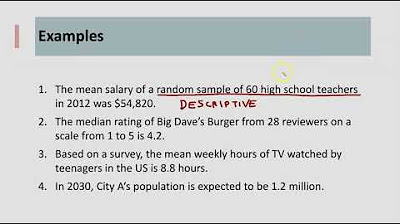Is STATISTICS hard?
TLDRIn the video, Michael Princhak, a statistics educator, introduces viewers to the world of statistics, emphasizing its importance in understanding patterns and trends in data. He explains that statistics involves the collection, organization, analysis, and interpretation of data, and can be used for making predictions and drawing conclusions. The video outlines the process of statistical analysis, from formulating a question to collecting and analyzing data, and finally interpreting results. Princhak highlights the challenges of statistical inference, which requires a solid understanding of probability. He encourages viewers to practice applying statistical concepts to different problems, as this is key to mastering the subject. The video also promotes his YouTube channel and review materials designed to help students prepare for exams and understand the practical applications of statistics.
Takeaways
- 📚 Statistics is a branch of applied mathematics that deals with the collection, organization, analysis, interpretation, and inference of data.
- 🔍 It helps us understand general patterns and trends in data sets and is used for analyzing data and making predictions about future events.
- 🤔 The process of statistics involves formulating a question, collecting data, analyzing it, and interpreting the results to answer the initial question.
- 📊 Organizing data and creating graphs is relatively simple, but the more complex aspects come into play when discussing statistical inference.
- 🧮 Inference requires a strong understanding of probability, as it involves making judgments about a population based on sample statistics.
- 💻 Technology plays a significant role in statistics, helping with calculations such as confidence intervals, Z-scores, T-scores, and P-values.
- 📈 The challenge in statistics is not the complexity of the math itself but understanding the concepts and applying them to various problems.
- 📚 Practice is crucial for mastering statistics, as it involves applying concepts to a wide range of problems and scenarios.
- 📈 Michael Princhak's videos aim to explain concepts and demonstrate their application in different scenarios, providing a comprehensive understanding of statistics.
- 📒 He also offers a review packet with study guides, practice questions, and resources to prepare for exams.
- 📉 Key skills in statistics include selecting appropriate methods, describing patterns and relationships in data, and using probability and simulation to explore random phenomena.
- 🗣️ Statistical argumentation, which involves developing explanations or justifying conclusions using evidence from data, is an essential skill.
Q & A
What is the primary focus of Michael Princhak's video content?
-Michael Princhak primarily focuses on AP Statistics, but also covers introductory, college, and high school level statistics.
What is the core of statistics according to the video?
-Statistics is the branch of Applied Mathematics that involves the collection, organization, description, analysis, interpretation, and inference of conclusions from quantitative and categorical data.
How does statistics help in understanding general patterns and trends in a dataset?
-Statistics helps by analyzing data and drawing conclusions from it, which can also be used for making predictions about future events and behaviors.
What does the video suggest is the first step in the statistical process?
-The first step in the statistical process is formulating a question that you want to investigate through data analysis.
What are some examples of questions that can be explored using statistics?
-Examples include whether listening to music helps or hinders learning, the certainty of an athlete's drug test failure, the impact of having a pet on longevity, the predictive power of SAT scores, recycling habits, weight loss diets for children, the effectiveness of new drugs for smoking cessation, and poker strategies with pocket aces.
How does one collect data in statistics?
-Data can be collected through a census, sample study, observational study, or an experiment.
What is the role of probability in statistical inference?
-Probability is crucial in statistical inference as it helps determine the likelihood of a sample occurring based on assumptions about the population from which the sample is drawn.
What are some of the mathematical concepts that students will encounter in statistics?
-Students will encounter concepts such as confidence intervals, Z-scores, T-scores, and P-values in statistics.
Why is practice important in statistics?
-Practice is important because it helps students understand how to apply statistical concepts to different problems, which is essential for grasping the subject matter.
What does Michael Princhak offer to help students prepare for their unit tests and AP exam?
-Michael Princhak offers an ultimate review packet with study guides, practice multiple-choice questions, and practice free-response questions.
What skills are involved in statistical argumentation?
-Statistical argumentation involves developing an explanation or justifying a conclusion using evidence from data, definitions, or statistical inference.
How does the video describe the difficulty level of statistics?
-The video describes statistics as not being as easy as taking candy from a baby, but also not as difficult as trying to steal a bone from a pit bull, emphasizing that it's about understanding uncertain data to make trustworthy conclusions.
Outlines
📚 Introduction to Statistics and Its Importance
Michael Princhak introduces himself as a creator of educational videos on a wide range of statistics topics, with a primary focus on AP Statistics. He emphasizes that statistics is a branch of applied mathematics that deals with the collection, organization, analysis, interpretation, and drawing of conclusions from data. The field is crucial for understanding patterns and trends within datasets and is applicable to various scenarios, from predicting future events to making informed decisions. Princhak outlines the statistical process, which begins with formulating a question, collecting data through various methods, analyzing the data, and finally interpreting the results to answer the initial question. He highlights that while understanding and collecting data is relatively straightforward, the challenging part lies in statistical inference, which requires a solid grasp of probability. Princhak reassures viewers that despite the complexity, technology will aid in calculations, and emphasizes the importance of practice in mastering statistics. He also mentions his review packet, which includes study guides and practice questions to prepare for exams.
🔍 Embracing Uncertainty: The Role of Statistics
In the second paragraph, Princhak discusses the role of statistics in making sense of an inherently uncertain world. He stresses that statistics aims to provide trustworthy conclusions based on data analysis. He assures viewers that he will be a guiding presence on YouTube, helping them through their statistical journey. Princhak encourages viewers to subscribe to his channel, explore his videos, and learn at their own pace. He concludes by reminding everyone that while statistics may not be as simple as it seems, it is not an insurmountable challenge and looks forward to assisting them in their learning process.
Mindmap
Keywords
💡Statistics
💡AP Statistics
💡Data Collection
💡Data Analysis
💡Inference
💡Probability
💡Confidence Intervals
💡Z-scores
💡T-scores
💡P-values
💡Practice
💡Statistical Argumentation
Highlights
Michael Princhak creates videos on a wide range of statistics topics, focusing primarily on AP Statistics.
Statistics is the branch of applied mathematics involving data collection, organization, analysis, interpretation, and inference.
Statistics is crucial for understanding general patterns and trends in data sets and making predictions about future events.
The process of statistics begins with formulating a question, such as the impact of music on studying or the effectiveness of diets.
Data is collected through methods like census, sample study, observational study, or experiment.
Data analysis involves organizing, graphing, calculating summary statistics, and comparing data to understand and make sense of it.
Interpreting results and drawing inferences to answer the initial questions is the final step in the statistical process.
Inference, a key part of statistics, involves making judgments about a population parameter based on a sample statistic.
Probability plays a significant role in statistical inference, as it helps determine the likelihood of sample occurrence.
Technology aids in performing complex calculations such as confidence intervals, Z-scores, T-scores, and P-values.
Understanding the mathematical concepts and their application is more important than just knowing the formulas.
Practicing with various examples is essential for mastering statistics, as it helps in applying concepts to different problems.
Michael's videos aim to explain concepts and demonstrate their application in multiple scenarios.
An ultimate review packet is available, providing study guides, practice questions, and resources for unit tests and AP exams.
Key skills in statistics include selecting methods for data analysis, describing patterns and relationships, and statistical argumentation.
Statistics is about understanding data in an uncertain world and making trustworthy conclusions.
Michael offers support and guidance on YouTube for anyone learning statistics.
The channel provides a variety of videos to help users understand and apply statistical concepts.
Transcripts
5.0 / 5 (0 votes)
Thanks for rating:





